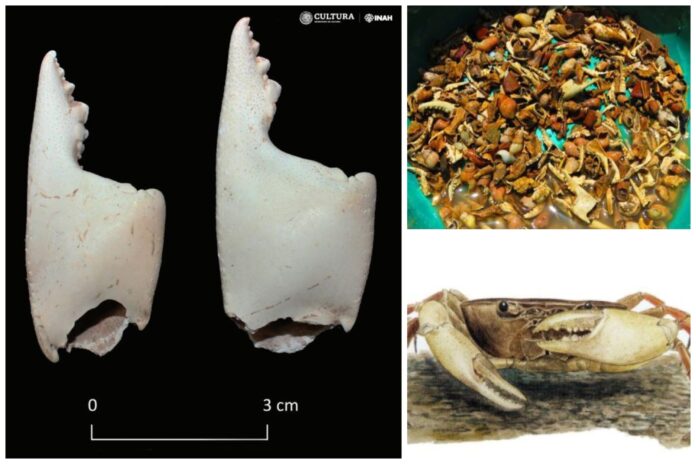Archaeologists have uncovered the remains of food eaten by ancient Maya elites during special ritual banquets.
Researchers from Mexico’s National Institute of Anthropology and History (INAH) have identified more than 1,300 freshwater crab remains found in ritual deposits at the Palace of Palenque, a renowned Maya archaeological site in the southern state of Chiapas.
The palace is the largest architectural complex in the ancient city, which was occupied for centuries, reaching its zenith between A.D. 500 and A.D. 700, when its influence extended throughout the surrounding region, according to UNESCO.
The archaeological site contains some of the finest architecture, sculptures and carvings that have survived from the ancient Maya civilization.
National Institute of Anthropology and History
The Maya civilization dominated what is now southeastern Mexico, Guatemala, Belize and the western areas of El Salvador and Honduras for more than 3,000 years until the era of Spanish colonization.
The ancient Maya were notable for their striking architecture and art; advanced calendar, mathematics and astronomical system; and for creating the only fully developed writing system in pre-Hispanic America.
The ruling and priestly elites of ancient Palenque used to enjoy endemic freshwater crabs, which they consumed as a delicacy in private ceremonies that commemorated special events, such as certain milestones in the palace’s construction.
These crabs were considered to be a symbolic marker of regeneration. They were therefore consumed in ceremonies that marked the inauguration or closing of certain spaces and constructions within the palace complex at the city’s height, according to archaeologists.
The latest findings have shed new light on the rituals that took place at the Palace of Palenque hundreds of years ago.
INAH researcher Carlos Varela Scherrer, who was involved in the investigations that uncovered the crab remains, said some modern-day Maya communities in northern Chiapas prepare large quantities of food on the eve of certain festive days. Afterward, they pour the remains of the food into excavated holes as an offering to the deities—as would have occurred in pre-Hispanic times.

iStock
“For the ancient Maya, it was important to hold ritual banquets where food was shared between the participants and the deities. Therefore, the recovery of crabs in Palenque opens new interpretations about the use of fauna and its cuisine,” Scherrer said in a press release.
The researcher specializes in studying the remains of animals found in these kinds of deposits. The discovery of crab parts stands out because of the fragility of their remains, which are rarely recovered in archaeological contexts in the Maya Lowlands.

Two ritual deposits were uncovered during the recent research. As part of the latter, the researchers found an anthropomorphic stucco head with the probable representation of an ancient ruler of Palenque, a ceramic vessel depicting a Maya deity and a pipe in the shape of a river prawn, alongside the crab remains.
“In general terms,” Scherrer said, “we were able to appreciate that these deposits are the product of events that were characterized by the consumption and burning of food and other objects, which were placed over cavities excavated in the floors and quickly covered again, enabling the exceptional conservation of archaeological material.”
Do you have a tip on a science story that Newsweek should be covering? Do you have a question about the ancient Maya? Let us know via [email protected].
Uncommon Knowledge
Newsweek is committed to challenging conventional wisdom and finding connections in the search for common ground.
Newsweek is committed to challenging conventional wisdom and finding connections in the search for common ground.


